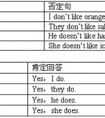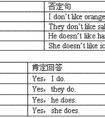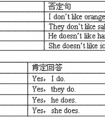用所给词的适当形式填空。1.Canyou(help)mewithmyChinese?Sure.2.Howmany(child)arethereinthecar?Three.3.Look!Thegirl(dance)underthetree.4.I(take)partinthesp-六年级英语
7. 初中课本中表示“某国人”的名词复数形式变化可通过歌诀记忆:中日不变英法变,其余 -s 加后面。
例如:Chinese → Chinese, Japanese → Japanese;
Englishman → Englishmen, Englishwoman → Englishwomen, Frenchman → Frenchmen, Frenchwoman → Frenchwomen;
American → Americans, Rusian → Rusians, Arab → Arabs, German → Germans 等。
8. 不可数名词一般只有单数形式,没有复数形式。有些不可数名词可借助单位词表示一定的数量。
例如:a cup of tea 一杯茶
, two piece of paper 两张纸, an item of news 一则新闻
考点名称:名词所有格
- 名词所有格:
表示有生命的东西的名词及某些表示时间、距离、星球、世界、国家等无生命的东西的名词后加’s来表示所有关系,叫做名词所有格。
例如:men’sroom男厕所
ChairmanMao’sworks毛主席著作
amile’sdistance一英里的距离
astone’sthrow一步之遥
themoon’slight月光
但如果该名词是以-s或-es接尾,则只在该名词后加“’”来构成所有格。
例如:3hours’walk三小时的路程
fiveminutes’walk五分钟路程
twomiles’distance两英里的距离 名词所有格用法:
一、’s所有格用法:
1)以s结尾的复数名词直接加“ ' ” 其余加“ 's ”
2)以s结尾的人名加“ ' ”或加“ 's ”
例如:Have you read Robert Browning’s poems?你读过罗伯特-勃郎宁的诗吗?二、of 所有格用法:
凡不能加’s的名词,都可以与of构成短语,来表示所有关系。无生命名词的所有格也可以这么用。
例如:Does anyone know the title of the novel?有谁知道这部小说的名字?
There is a tall maple tree at the end of the road.在这条路的尽头有一棵高高的枫树。
但有特殊情况:
This is a photo of my parents.
如果名词后面有一个较长定语,尽管名词表示有生命的东西,也可以用这种所有格形式。
例如:Did you listen to the speech of the President Clinton over the radio?你听了克林顿总统的广播讲话了吗?
They have the support of the people of the developing countries.他们得到发展中国家人民的支持。三、双重所有格:
所谓“双重所有格(double genitive)”,是指名词所有格或名词性物主代词同of构成的所有格,即“of+名词所有格”。
双重所有格有以下几个特征:
1)“of+名词所有格”中的名词必须表示人,不能表示事物。因此,我们可以说:
a play of Shakespeare’s(莎士比亚的一个戏剧), a friend of my wife’s(我妻子的一个朋友),但却不能说a funnel of the ship’s或 a leg of a table’s,
而且该名词必须是特指的,不能是泛指的。
我们可以说:a friend of the doctor’s(这位医生的一个朋友),a novel of the writer’s(那位作者的一部小说),而不能说a friend of a doctor’s或 a novel of a writer’s。
2)除了修饰的原因外,用双重所有格主要是由于被修饰词有排他性的限定词。
如冠词、某些不定代词、指示代词、疑问代词、数词等。
比如我们不能说 an our old acquaintance,而必须说an old acquaintance of ours(我们的一个老相识);
不能说many their books,正确的说法是 many books of theirs(他们的许多书)。
3)注意区别下列四种表达方式含义的差别:
one of my brother’s friends(明确表示我兄弟有一个以上的朋友)
a friend of my brother’s(暗示我兄弟有一个以上的朋友)
a friend of my brother(对我兄弟有好感的人)
my brother’s friend(我兄弟唯一的一个朋友或刚谈及的那一个朋友)四、特殊所有格:
若一样东西为两人共有,则后一个人名用所有格;如果不是两人共有,而是各有各的,则两个名词都用所有格,且其后名词应为复数。例如:
The woman dressed in blue is Mary and Alice’s mother.
那个穿蓝衣服的妇女是玛丽和爱丽丝的母亲。
You should find what the difference between Mr. Smith’s and Mr.Black’s cars is.
你应当发现史密斯先生与布莱克先生的汽车的不同之处。
考点名称:序数词
- 序数词:
即表示顺序的数词。
A、1-3的序数词。 第1 first 第2 second 第3 third
B、4-19的序数词的表示方法,是由“基数词+ th”构成。
如:第4 fourth 第5 fifth 第8 eighth 第18eighteenth
C、20-100的序数词的表示方法。
a. 整数的表示方法,是把整数基数词的词尾“y”改写成“i”,然后加-eth,如:第20 twentieth 30 thirtieth
b. “百”的序数词的表示方法是在hundred词尾直接加“-th”如:第100 a hundredth
c. 其他两位数序数词的表示方法:由基数词变化而来,十位数不变,个位数上的基数词变成序数词,中间用连字符“-”连接。如:第21 twenty-first 第52 fifty-second - 序数词的缩写:
有时,序数词可以用缩写形式来表示。主要缩写形式有。
first—lst
second—2nd
third—3rd
fourth—4th
sixth—6th
twentieth—20th
twenty-third——23rd
其中lst,2nd,3rd为特殊形式,其它的都是阿拉伯数字后加上th。 - 基数词变序数词方法口诀:
口诀 解说 举例 基变序,有规律,后边th加上去 在数词后面加th。 four→fourth 一二三,特殊记,后面字母t,d,d。 one,two,three特殊变。 first,second,third 八去t,九去e。整数中的y要变成ie eight去掉t,nine去掉e。twenty去掉y变成twentieth eight→eighthnine→ninth f来把ve替。 five和twelve的ve要变成f。 five→fifthtwelve→twelfth 若是遇到几十几,只变个位就可以。 两位数或两位以上数字只变个位。 thirty-three→thirty-third 序数词前要加the我们一定要牢记。 序数词前必须加the(上述原则中的除外) thefirstday 序数词表示法:
一、分数表示法
1. 分数是由基数词和序数词一起来表示的。基数词作分子,序数词作分母,除了分子是“1”以外,其它情况下序数词都要用复数形式。
3/4 three fourths或 three quarters
1/3 one third或a third
24/25 twenty-four twenty-fifths
3又1/4 three and one fourth或 three and one quarter
1/2 a half
1/4 one quarter或a quarter
1又1/2 one and a half
1又1/4 one and a quarter
2. 当分数后面接名词时,如果分数表示的值大于1,名词用复数;小于1,名词用单数。
1又1/2 hours 一个半小时(读作 one and a half hours)
2又3/4 meters 二又四分之三米(读作two and three-fourths meters)
4/5 meter 五分之四米
5/6 inch 六分之五英寸
3. 表示“n次方”的说法:指数用序数词,底数用基数词。
10的7次方 the seventh power of ten(ten to the seventh power)
6的10次方 the tenth power of six(six to the tenth power)二、百分数表示法
百分数用基数+percent表示
50% fifty percent 百分之五十
3% three percent 百分之三
0.12% zero point one two percent 百分之零点一二
这里的percent前半部per表示“每一”,cent这一后半部分表示“百”,所以百分之几中percent不用复数形式。三、数量表示法
1. 表示长、宽、高、面积等,用基数词+单位词(meter,foot,inch,kilogram等)+ 形容词(long,wide,high等)表示,或者用基数词+单位词 + in + 名词(length, width, height, weight等)表示。
two meters long或 two meters in length 2米长
three feet high或 three feet in height 3英尺高
four inches wide或 four inches in width 4英寸宽
This box is 2 kilograms in weight.
这个盒子有两千克重。
The city wall of Xi/’an is 12 meters wide and 12 meters high.
西安城墙是12米宽,12米高。
2. 表示时间、距离时,使用含数词的名词所有格形式作定语。
five minutes/’ walk
步行五分钟(的距离)
It/’s an hour/’s ride from my hometown to our university.
从我的家乡到我们大学是乘车一小时的路程。
或:从我的家乡到我们大学需要乘车一小时。
It/’s three kilometers/’ distance from our campus to the Bell Tower.
- 最新内容
- 相关内容
- 网友推荐
- 图文推荐
| [家长教育] 孩子为什么会和父母感情疏离? (2019-07-14) |
| [教师分享] 给远方姐姐的一封信 (2018-11-07) |
| [教师分享] 伸缩门 (2018-11-07) |
| [教师分享] 回家乡 (2018-11-07) |
| [教师分享] 是风味也是人间 (2018-11-07) |
| [教师分享] 一句格言的启示 (2018-11-07) |
| [教师分享] 无规矩不成方圆 (2018-11-07) |
| [教师分享] 第十届全国教育名家论坛有感(二) (2018-11-07) |
| [教师分享] 贪玩的小狗 (2018-11-07) |
| [教师分享] 未命名文章 (2018-11-07) |



![—Can you swim?—Yes ,________[ ] A. I can'tB. I canC. I am-三年级英语](http://www.00-edu.com/d/file/ks/4/1/46/2019-08-24/smallae208768e77b392cb00a5a8a687f84961566582505.jpg)
![_____________ I see that toy panda? [ ]A. canB. mayC. May-五年级英语](http://www.00-edu.com/d/file/ks/4/1/46/2019-08-24/small440f55b4860d5c9b87889948786e71451566582371.jpg)

